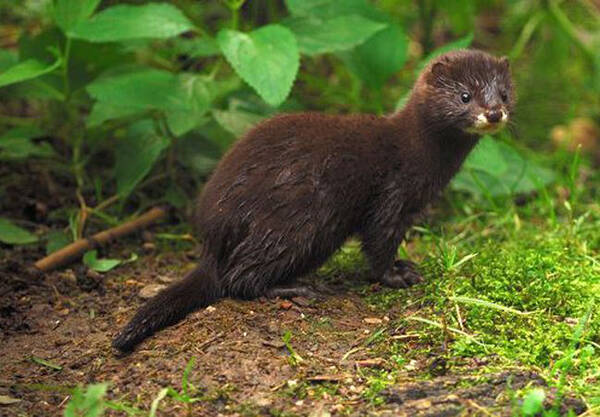Mustela lutreola
IUCN
LCBasic Information
Scientific classification
- name:Mustela lutreola
- Scientific Name:Mustela lutreola,European Mink,European water mink
- Outline:Carnivora
- Family:mustelae genus
Vital signs
- length:28-43cm
- Weight:600-1000g
- lifetime:6-12years
Feature
It is one of the most endangered mammals in Europe.
Distribution and Habitat
Origin: France, Romania, Russian Federation, Spain, Ukraine.
Regional extinction: Austria, Belarus, Bulgaria, Croatia, Czech Republic, Finland, Georgia, Germany, Hungary, Kazakhstan, Latvia, Lithuania, Moldova, Montenegro, Netherlands, Poland, Serbia, Slovakia, Switzerland.
Recovered: Estonia.
The European weasel is semi-aquatic and inhabits vegetated lake shores, rivers, streams and marshes. They are rarely found more than 100 meters from fresh water. The European weasel may live in the dens and burrows of muskrats (Ondatra zibethicus). These may be abandoned burrows, but they may also be occupied, but the European weasel will take over and occupy these nests, killing and eating the original owner. The European weasel will also make dens in natural burrows in riverbanks, under trees and in drift piles, lining them with grass, leaves, fur or feathers.
Appearance
The European water ferret is one of the most endangered mammals in Europe. They are a medium-sized mustelid, with a head-body length of 28-43 cm and a total length of 35-58 cm; males can weigh up to 1000 g and females up to 600 g. They are slender, with an arched back, short legs, and a short, densely furred tail. The body fur is usually dark brown, with a distinctive band of white fur around the upper and lower lips and occasionally on the throat. Male and female European water ferrets look very similar, but males are 80% larger than females. The pups are similar in appearance to the adults.
This marking and the smaller size usually distinguish the European water ferret from the American water ferret, but occasionally some individuals may look so similar that only a skeleton or genetic analysis can guarantee a correct species identification.
The dense fur layer of the European water ferret is short even in winter, but it has a thick, waterproof undercoat that insulates it from w
Details
The European Mink (scientific name: Mustela lutreola) is a medium-sized mustelid with a total of 7 subspecies.

The European Mink is a wanderer, occupying rivers up to 15 kilometers in length and rarely using the same cave. Females usually stay close to their dens, unless food is scarce, in which case they will seek another home. European ferrets are solitary except during the breeding season from February to March, when they are breeding and need to find a mate, using hissing sounds and screams to spread the word of their home. Males usually look for females whose territories overlap first.
European ferrets are primarily nocturnal animals, emerging from their dens at night to eat small animals, including water voles, birds, frogs, mollusks, crabs, fish, and insects. This ability to hunt in water, on land, in marshes, and in caves far exceeds that of more specialized prey such as otters and weasels.
European ferrets tend to be very active contacts between the sexes before mating. The female's gestation period is between 5-10 weeks, and the pups are born in the spring, when food is plentiful in the territory. Female European ferrets give birth to 2-7 pups per litter and nurse for 5-6 weeks. Pups are born blind and helpless, so they are dependent on their mother until they are weaned at around 10 weeks of age and leave the nest at 12-18 weeks of age. The species reaches sexual maturity after one year and lives around 6 years in the wild and up to 12 years in captivity.
European ferret populations are subject to a range of ecological and commercial threats. Habitat loss and degradation are serious threats to this sensitive species in parts of Europe, and as of 2016, hydropower development and water pollution have increased significantly over the past few decades. Another major cause of the decline of the European ferret is commercial trapping for its fur. Although the fur of this species is less valuable than that of the American water ferret, overexploitation has led to a decline in numbers. In addition, the American water ferret, introduced in 1926, has created severe competition for food and habitat with the European ferret and has significantly reduced the population of this native species. Accidental deaths from pesticide use on farmland, accidental poisoning, and vehicle collisions are particularly frequent in the western regions where the European ferret lives. All water ferret species are also susceptible to Aleutian disease, a highly contagious virus that can cause persistent infection and often death. Due to these threats, the European ferret population is thought to have declined by more than 90% since the early 20th century, with small, fragmented populations that continue to decline.
Listed on the 2016 IUCN Red List of Threatened Species, ver 3.1 - Critically Endangered (CR).
Protect wildlife and eliminate game.
Maintaining ecological balance is everyone's responsibility!








